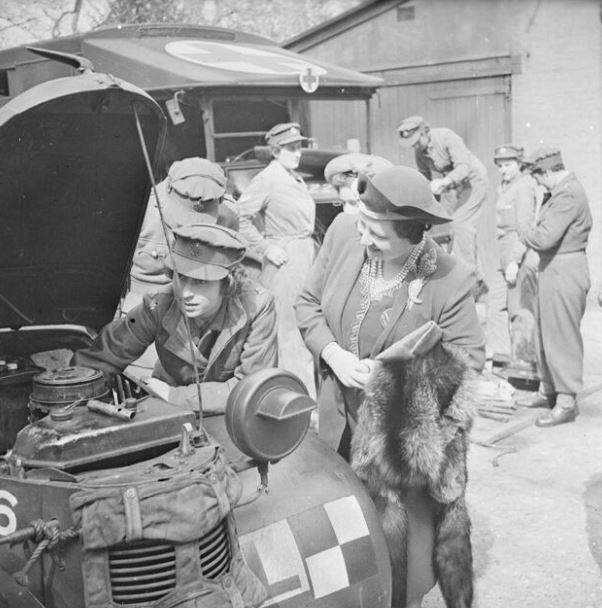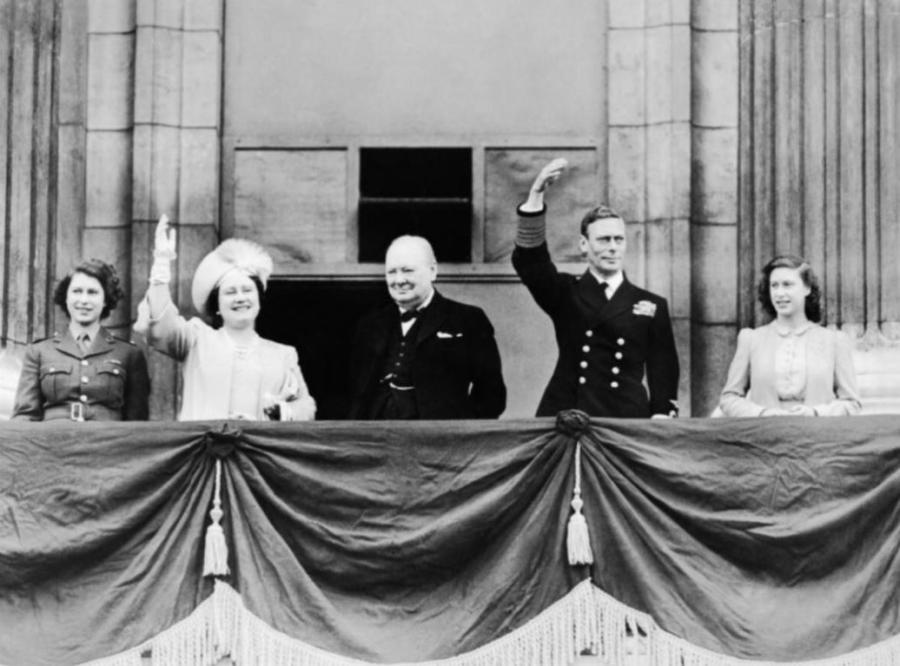A princess at war

Princess Elizabeth, wearing her ATS uniform, stands in front of an ambulance, in April 1945. Photo: Courtesy Imperial War Museum IWM (TR 2835)
In 1947, on her 21st birthday, Queen Elizabeth II, pledged to devote her life, whether it be long or short, to the service of her people.
Like so many of her generation, the then Princess Elizabeth had grown up during the Second World War and volunteered to serve.
Within a year of turning 18, the future Queen had joined the Auxiliary Territory Service, learning to drive and maintain trucks, becoming the first woman in the Royal Family to become a full-time member of the armed services.
It was decision that would shape the rest of her life and reign.
When the Second World War broke out in September 1939, Princess Elizabeth was just 13 years old, and her younger sister, Princess Margaret, was nine.
Their father, King George VI, had addressed the people of Britain and the Empire in a radio broadcast at 6 pm on September 1939, speaking of the difficult times ahead, and urging people to stand firm.
From the beginning, the King and his wife, Queen Elizabeth, were determined they would not be seen to be hiding from the war.
The King and Queen visited areas that had been bombed during the Blitz, speaking to residents and members of the local emergency services. They also visited serving personnel, munitions factories, RAF bases and Royal Navy ships, as well as troops training for combat in a bid to keep people’s spirits up and boost morale during the war.
The Queen wanted to keep the family together at Buckingham Palace. But in 1940, at the height of the Blitz, the two young princesses were evacuated to Windsor Castle to escape the threat of German bombing raids.
The princesses were two of more than three million people – mostly children – who were evacuated from London and other cities across Britain to the safety of smaller towns and the countryside during the war.
There had been suggestions the two young princesses should be evacuated to the United States or Canada, but their mother refused.
“The children won’t go without me. I won’t leave the King. And the King will never leave,” she said.

King George VI and Queen Elizabeth inspecting bomb damage at Buckingham Palace, September 1940. One member of palace staff was killed in the raid. Photo: Courtesy Imperial War Museum IWM HU 63234
In September 1940, five high explosive bombs were dropped on the Buckingham Palace. Rather than flee the city, the King and Queen decided to remain at Buckingham Palace in solidarity with those living through the Blitz. The Queen reportedly said, “I’m glad we have been bombed. Now we can look the East End in the eye.”
Buckingham Palace would be bombed nine times during the war, but the princesses and their mother would remain in England for the duration of the war.
The two young princesses spent most of the war years at Windsor Castle, where they were subject to the same rationing as others and were regularly bundled off to underground vaults as bombs rained down on the Windsor Great Park.
It was during the war that Princess Elizabeth carried out her first public duties.
On 13 October 1940, the 14-year-old princess made her first radio broadcast from the drawing room of Windsor Castle, as part of the BBC’s Children’s Hour, urging child evacuees to have courage.
“Thousands of you in this country have had to leave your homes and be separated from your fathers and mothers,” she said. “My sister Margaret Rose and I feel so much for you, as we know from experience what it means to be away from those you love most of all ... We are trying to do all we can to help our gallant sailors, soldiers, and airmen, and we are trying, too, to bear our share of the danger and sadness of war. We know, every one of us, that in the end, all will be well.”
She became the Colonel of the Grenadier Guards in 1942, and on the morning of on the morning of her 16th birthday, carried out her first official public engagement, inspecting the guards at Windsor Castle.
In 1943, she was photographed tending allotments at Windsor Castle as part of the government’s “Dig for Victory” campaign, in which people were urged to use gardens and every spare piece of land to grow vegetables to help combat food shortages in Britain.
She also launched her first ship, HMS Vanguard, at Clydebank in Scotland when she was 18, and performed some of her father’s duties as head of state while he was in Italy in 1944.
But the young princess was determined to do more.

Princess Elizabeth, wearing cap and overalls, changes the wheel of a car, during an ATS Vechile Maintenance class in April 1945. The press dubbed her "Princess Auto Mechanic" at the time. Photo: Courtesy Imperial War Museum IWM H 41668
When she turned 18 in April 1944, she decided she wanted to do her bit for the war effort, as so many of her peers were.
At first, her father, the King, was against the idea of the princess joining the women’s auxiliaries or working in a factory, but eventually Elizabeth got her way.
Within a year, Princess Elizabeth had enlisted in the Auxiliary Territorial Service, the women’s branch of the British Army, known as the ATS.
Known as truck mechanic No. 230873, she began her training in March 1945. She completed a driving and vehicle maintenance course where she learnt how to service, maintain and drive heavy vehicles and was pictured, dressed in overalls, working on engines and changing tyres. She was dubbed “Princess Auto Mechanic” by the newspapers.
Based at the ATS No. 1 Mechanical Transport Training Section in Camberley, Surrey, she worked seven-hour days, but would return to Windsor Castle each night.
The King and Queen visited the training camp with Princess Margaret, where they watched the future Queen learn about engine maintenance.
Describing the visit to Life Magazine, the then Princess Elizabeth commented, “I never knew there was quite so much advance preparation [for a royal visit] ... I’ll know another time.”
Princess Elizabeth graduated as a qualified driver after five months of training as a mechanic and truck driver at Camberley, and was promoted to the honorary rank of junior commander.
"I began to understand the esprit de corps that flourishes in the face of adversity," she later recalled.

Princess Elizabeth explains to her mother, the Queen, the work she has done on the engine. Photo: Courtesy Imperial War Memorial IWM H 41644
On VE Day – 8 May 1945 – Princess Elizabeth joined her parents and her sister on the balcony at Buckingham Palace, to greet the crowds of people who had gathered on the streets of London to celebrate the end of the war in Europe.
As the celebrations continued into the night, Princess Elizabeth, dressed in her ATS uniform, was allowed to leave the palace with her younger sister and mingle with the crowds, anonymously.
There are even reports that the two young princesses joined a conga dance through the Ritz Hotel as they celebrated with the crowds.
She would later describe it as one of the most memorable nights of her life.
“We asked my parents if we could go out and see for ourselves,” she said. “I remember we were terrified of being recognised so I pulled my uniform cap well down over my eyes … I remember lines of unknown people linking arms and walking down Whitehall, all of us just swept along on a tide of happiness and relief.”

Princess Elizabeth appeared on the balcony of Buckingham Palace with her family and British Prime Minister Winston Churchill. Photo: Courtesy Imperial War Museum IWM MH 21835
After the war, Princess Elizabeth saved up ration coupons to pay for the material to make her wedding dress, like thousands of other brides. Britain was still recovering from the war when she married Prince Philip in 1947, and materials remained scarce. The princess was so popular, many Britons donated their own clothing coupons to help, but these had to be returned as it was illegal to give them away.
Just seven years after the end of the war, Elizabeth became Queen.
In February 1954, she became the first reigning British monarch to visit Australia.
During the eight-week Royal Tour of Australia, the Queen and Prince Philip visited the Australian War Memorial, where they toured the Commemorative Area and laid a wreath at the Stone of Remembrance.
The Queen visited Australia 16 times, returning to the Memorial numerous times.
Her last visit to the Memorial was in 2011, when she toured the Hall of Memory and laid a wreath at the Tomb of the Unknown Soldier.
She would go on to become the longest-serving British monarch in history.
The war years had played a major role in shaping her life, and her reign.
Her Majesty the Queen accompanied by Dr C.E.W (Charles) Bean, Chairman of the Board of Management of the Australian War Memorial, passes along the ranks of the relatives of deceased ex-servicemen and women, after her visit to the Hall of Memory, seen in the background.
